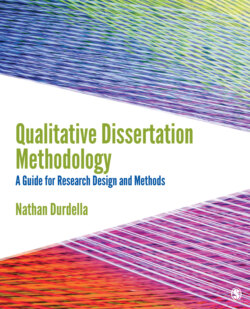Читать книгу Qualitative Dissertation Methodology - Nathan Durdella - Страница 82
На сайте Литреса книга снята с продажи.
Flexibility within conventional qualitative dissertation methodology.
ОглавлениеA section-by-section approach has limitations: an implied linear progression from one section to the next (even though there are iterative steps within and between sections), a structured chapter framework and ordered sequence of sections, and a use of specific terms with little variation. While all of these characteristics distinguish the section-by-section approach used in this book, they tend to reflect the conventional approach to qualitative dissertation methodology (which tends to mirror broader social science research standards). What is more, this approach generally offers a flexible, fluid space to allow for adaptation across program requirements, advisor preferences, and student interest in both a traditional format of dissertation methodology and newer or emerging approaches of qualitative dissertation research.
The key features throughout the book offer opportunities to relate concepts to your own work and use student samples as guides to shape what you are doing or will do in your study. In fact, the use of multiple terms to describe dimensions of qualitative dissertation methodology, application of practices in developing a methodology chapter, and presentation of a diverse set of doctoral student samples (Table 2.4) moves you through a building-block framework. With the thrust of the work to draft, revise, and finalize, a qualitative dissertation methodology seems to take place at the granular level—how to do this, when to do that, why take these steps—using elements of a step-by-step approach will support your overall efforts. With the long view of the research framework to inform the major decisions and minute details of the methodology chapter, the resources that you can borrow to sketch out a roadmap and plan for fieldwork may be found in this book and work well for you.
Chapter Summary
This chapter examined the historical and contemporary contexts of dissertations. Looking at the foundations of current and emerging approaches to dissertation research in graduate education, the chapter focused on the historically and socially reproduced formats and rituals in dissertation research. Here, considerations of how dissertation research has served college and university faculty and functioned to support multiple activities in the academy and professional associations appeared in the chapter. Then, the chapter moved on to a closer look at what distinguishes dissertation research—especially conventional dissertation formats—from other types of scholarly research activities. Moving toward the approach to methodological development of a dissertation in this book, the chapter explored foundational elements of methodology in qualitative inquiry, including how methods and procedures work in a study. With a specific focus on the five-chapter monograph dissertation and explored features of book-length formats, the chapter discussed new and emerging dissertation forms and discussed patterns of digital and other technology-mediated forms of dissertation research. The chapter ended where it started: with the conventional dissertation format as a section-by-section approach to developing a qualitative dissertation methodology chapter.
